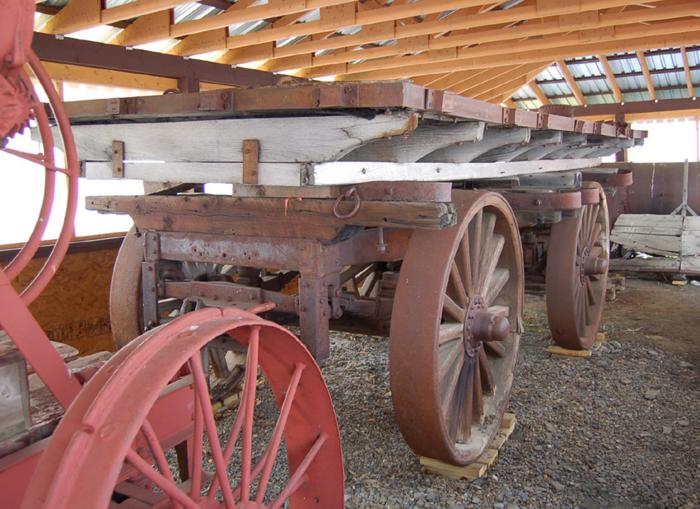Wagon
Object
2007.1.19
Huge wooden wagon, with metal reinforced wood wheels and spokes leading to wooden axels. The bed of the wagon sits high above the wheels. Wooden bed in also reinforced with metal slats to add to the strength of the wagon. The wood has greyed with age and the metal rusted in places or painted red to prevent rusting. Manufactured by the "Ohio Trailers" Company in "Cleveland, Ohio".
Wagons were an important part of the Keno mining industry. They and their horses carried all the required amenities during the summer. In the early days, there were no government maintained roads in the area and most roads were considered 'winter' roads. These huge wagons hauled the ore from the mines to the ore repositories nearly 60 kilometres away along the banks in Mayo, Yukon. They also carried freight back to the camps carrying supplies filled with provisions and equipment. They were considerable wagons, able to carry 10 tons of ore and navigate the somewhat difficult terrain of the Yukon. The wheeled wagons were used in summer, but even then, had substantial difficulties steering the conditions of the road. As the snow melted the road became soft and malleable often causing the wagon to get stuck in the mud or caught in a rut. In the summer, bumpy terrain and heavy loads could delay the transportation of the important cargo.
Much of the freight in the Keno area of the Yukon was handled by Pickering and Greenfield. In the 1915 or 1916 Jack Pickering teamed up with Jim Greenfield, a livery stable owner. They shipped up horses, hay and oats, heavy freighting sleighs, wagons, and harnesses. They won contracts to haul freight around Dawson, ore from the Silver King and Keno Hill to Mayo. They operated in the area until the 1930s.
Much of the freight in the Keno area of the Yukon was handled by Pickering and Greenfield. In the 1915 or 1916 Jack Pickering teamed up with Jim Greenfield, a livery stable owner. They shipped up horses, hay and oats, heavy freighting sleighs, wagons, and harnesses. They won contracts to haul freight around Dawson, ore from the Silver King and Keno Hill to Mayo. They operated in the area until the 1930s.
